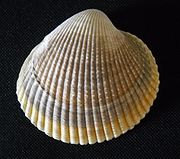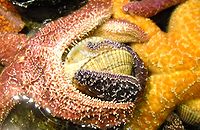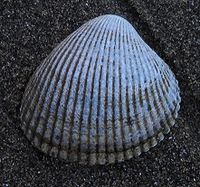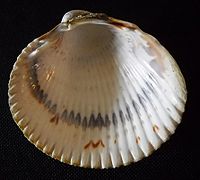Clinocardium nuttallii
From marinelife1011
The genus Clinocardium translates as "sloped heart" in Latin. The species is named after Thomas Nuttall, an English Explorer in the 19th century. They are largest cockle on the Pacific Coast of North America.
| Nuttall's Cockle | |
|---|---|
 |
|
| Clinocardium nuttallii | |
| Scientific classification | |
| Kingdom: | Animalia |
| Phylum: | Mollusca |
| Class: | Bivalvia |
| Order: | Veneroida |
| Superfamily: | Cardioidea |
| Family: | Cariidae |
| Genus: | Clinocardium |
| Species: | nuttallii |
| Binomial name | |
| Clinocardium nuttallii Conrad, 1837 |
|
| Synonyms | |
|
Cardium orbis |
|
Contents |
Description
C. nuttallii have distinctive thick valves (shells) with up to 35 radial ribs covering the entire valve. They can reach up to 14cm in length. The valves lock together by both the radial ribs on the ventral margin and set of internal flanges and groves on the dorsal margin. [1]
The most distinctive feature of C. nuttallii is the elongated foot which can exceed its valve length when fully extended. This organ allows for rapid mobility and a mechanism to escape from predators that sessile and buried bivalves cannot avoid. C. nuttallii have sensory organs on the mantle fringe, which responds particularly to the scent of various species of seastars.
Habitat
C. nuttallii inhabits protected bays and estuaries buried shallowly or on the surface of sandy substrate. Its short siphons restrict respiration and feeding to the very surface, therefore it only buries down a few centimeters deeper than its shell length.
Range
C. nuttallii ranges geographically from the Bering Sea of Alaska to San Diego, California, and can be found in the intertidal zone and down to 200 feet in the neritic benthos. [1]
Life History
C. nuttallii is an active filter feeder of phytoplankton and bacteria. It can pump 2.51 liters of water per hour per gram of body mass. [1]
Underwater predators include sea stars such as Pycnopodia helianthoides and Pisaster brevispinus and also crabs such as Cancer productus. When stranded intertidally, C. nuttallii are preyed upon by various species of gulls, who pick up and drop them from flight.
Escape mechanism
After detecting a predator, especially the Pycnopodia helianthoides, C. nuttallii relaxes its adductor muscles, and extends the elongated foot to push downward. This is repeated until the C. nuttallii is pushed up and away from the predator. These leaps can reach nearly three feet.
Reproduction
C. nuttallii reproduces by releasing eggs and sperm into the water column, where fertilization takes place. These larvae undergo metamorphosis from a planktonic tochophore into a veliger named after its larval swimming organ, the velum meaning "sail" or "veil" in Latin. After finding a suitable substrate, the veliger settles to the substrate and shes its velum to begin its benthic life. A simultaneous hermaphrodite, in the Puget Sound they mature in their second year and spawn in July and August. [1] They are believed to be able to self-fertilize but the conditions required for and the impacts of are not well understood. [2]
Human consumption of C. nuttallii
C. nuttallii has been eaten by the Native Americans of the Pacific Coast for thousands of years and have been found in shell midden. [3] They remain an important food source especially for the Native Americans of Canada.
Other species in the Cardiidae family such as Cerastoderma edule or the Common European Cockle are important commercially in European and Asian countries yet C. nuttallii, a similarly edible species, is not commercially harvested on the US Pacific Coast.
Liu et al., (2008, 2009, 2010) have demonstrated the feasibility of reliable hatchery production for C. nuttallii. Shellfish farmers have planted the "seeds", immature C. nuttallii intertidally, or suspended them in the water column. The suspended C. nuttallii tend to grow faster and have extremely high survival rates, as high as >96% (Epelbaum et al., 2009) but have the drawback of higher rates of deformities and fouling by algae which lowers their market value. [4]
Scientific Studies
Clinocardium nuttallii from Yaquina Bay, Oregon, were found to harbor an endosymbiotic algae (Hartman, Pratt 1976). The algae infects the siphon, mantle, and occasionally the foot. C. nuttallii under 2 years old are not infected and the incidence and intensity of the infection increases in the older age groups. The algae was found to be similar to those found in the genus Chlorella. This algae was determined to be a facultative parasite, after the authors demonstrated that algae had chloroplasts and only grew on areas of the C. nuttallii exposed to sunlight, the lack of harm to the C. nuttallii resulting from infection and the ability to culture the algae out of the host. [5]
Images
References
http://www.wallawalla.edu/academics/departments/biology/rosario/inverts/index.html
- ↑ 1.0 1.1 1.2 1.3 Cowles, Dave. Key to Invertebrates Found At or Near The Rosario Beach Marine Laboratory (a campus of Walla Walla University) Fidalgo Island, Anacortes, WA May 2009.
- ↑ Reproduction and Ecology of the Hermaphroditic Cockle (Clinocardium nuttallii) in Garrison Bay, Marine Ecology Vol 7 137-145 1982
- ↑ "Exploring Coast Salish prehistory: the archaeology of San Juan Island" Julie K. Stein, University of Washington Press, 2000
- ↑ Epelbaum, Pearce, Plamondon, Yuan, Guerney-Smith Aquaculture Potential of the Basket cockle (Clinocardium nuttallii) in British Columbia, Canada: Project Summary of the Nursery and Grow-out Phases, Fisheries and Oceans Canada, Issue Number: 104, December 2009
- ↑ M. C. Hartman, Ivan Pratt, Infection of the heart cockle, Clinocardium nuttallii, from Yaquina Bay, Oregon, with an endosymbiotic algae, Journal of Invertebrate Pathology, Volume 28, Issue 3, November 1976, Pages 291-299
FERTILIZATION AND EMBRYONIC DEVELOPMENT IN THE BASKET COCKLE, CLINOCARDIUM NUTTALLII. (Liu, Alabi, Pearce. Journal of Shellfish Research, Vol. 27, No. 2, 393–397, 2008)
All images by Micah Gelfand




